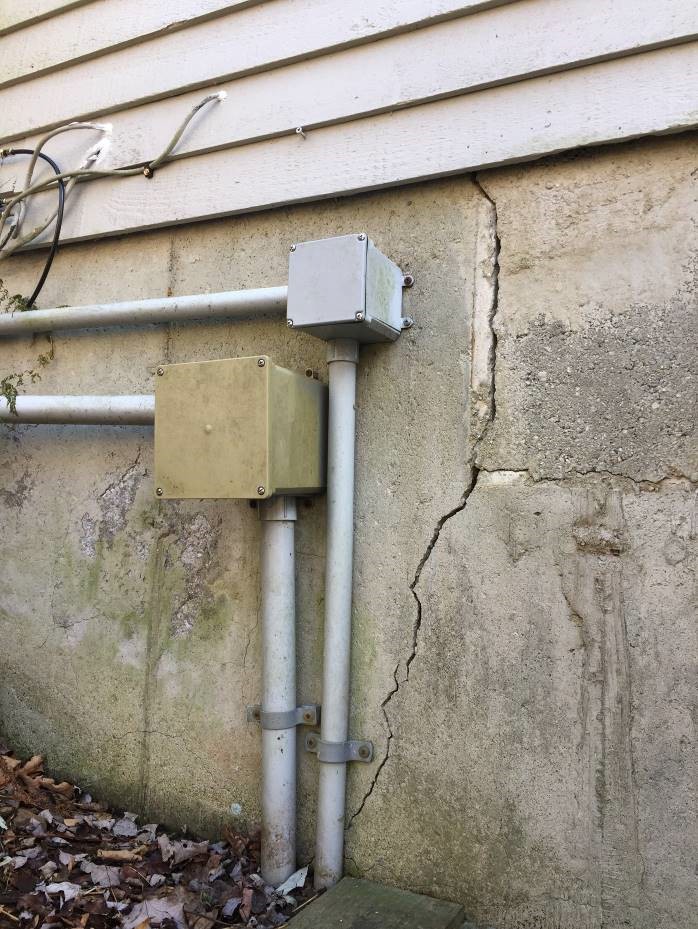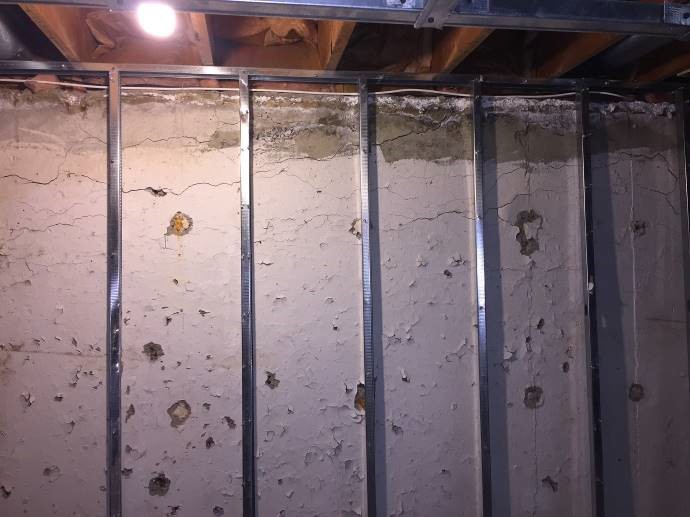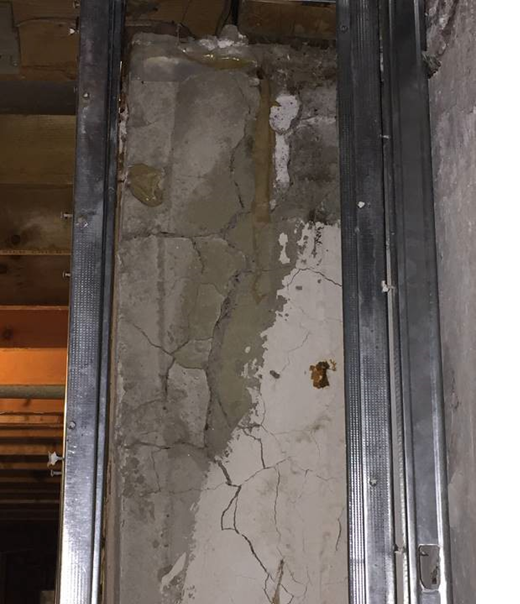Coordinating Federal Resources for a Non-Stafford Act Event
Learning Objective: Examine the collaborative federal interagency assistance initiative in Connecticut to address a non-declared emergency event: crumbling concrete foundations in thousands of residential homes.
Part One
Background

As many as 34,000 homes constructed in northeastern Connecticut between 1983 and 2000 may have concrete foundations containing pyrrhotite and are at risk of cracking or crumbling. Pyrrhotite is an iron sulfide that can be found naturally in aggregates, or rocky materials such as gravel, sand, or stone that are added to cement to make concrete. When iron sulfides are exposed to oxygen and water, a series of chemical reactions convert the iron sulfides into other compounds.
These other compounds are expansive – take up more space than the original iron sulfides – and ultimately lead to cracks or holes in the concrete. The cracks in the concrete foundations grow over time, putting the inhabitants of the homes and structures at risk.
Reports of crumbling foundations first began in 2015. By May 2017, the Connecticut Department of Consumer Protection (CDCP) had received reports of more than 550 homes with faulty foundations, and in December 2017 began processing 522 verified reports to determine compensation eligibility.
Collectively, the potential economic impact to the Connecticut’s housing market could approach up to $1 billion. This issue is also devastating to individual homeowners, whose home values decrease significantly if pyrrhotite is present. Potentially, tens of thousands of Connecticut residents may be affected as the quarry believed to be the source of the contaminated material was widely used throughout the state
Challenges
The only safe and effective method to fix a home that has tested positive for pyrrhotite is to lift the house off the existing foundation and completely replace all the concrete. According to the Connecticut Department of Housing, this process can cost anywhere from $100,000 to $250,000, often more than the total value of many affected homes.
Even before this issue came to light, Connecticut was facing economic challenges. Major industries leaving the state have led to a loss of jobs for residents, and the state’s fiscal reserves had begun to falter. A localized housing market crash could be devastating to Connecticut’s economy, which would make the state’s current budget crisis much harder to overcome.
Most insurance companies will not cover a foundation collapse that occurs slowly over time (as opposed to a sudden, devastating collapse), forcing affected homeowners to pay for repairs out-of- pocket or absorb the lost value of their home. For those who had sunk most of their assets into their home, the devaluation of their property left them with both a potentially unsafe place to live and loss of their primary investment. Without a private sector solution in sight, Governor Malloy sought federal assistance to avoid the looming economic crisis.
Adding to the challenges faced by the Governor’s administration, the event did not meet the requirements of a Stafford Act declaration and Connecticut would be unable to receive federal financial assistance through Stafford Act programs. The Governor was told that even in the absence of a Presidential declaration, FEMA, along with other federal agencies, would be able to provide technical assistance for this incident.
Part Two
Actions
Although this incident did not meet the requirements of a Stafford Act declaration, FEMA did appoint a Senior Federal Liaison to facilitate Connecticut’s engagement with other federal agencies in November 2016. The goal of the Federal Liaison appointment was to leverage federal authorities and available resources to support the state and local community efforts in assisting citizens with compromised foundations.
Key Federal Agency Partners
- U.S. Army Corps of Engineers (USACE)
- U.S. Department of Housing and Urban Development (HUD)
- U.S. Department of Agriculture (USDA)
- U.S. Economic Development Administration (EDA)
- U.S. Internal Revenue Service (IRS)
- U.S. Small Business Administration (SBA)
- U.S. Department of Veterans Affairs (VA)
- Federal Emergency Management Agency (FEMA)
Interagency collaboration was emphasized from the beginning of federal involvement in Connecticut. The National Coordinators of all six Recovery Support Functions (RSFs) were briefed on the situation and brought together to discuss the support they could potentially provide.
HUD assumed the role of lead federal coordinating agency, offering their local office in Hartford, Connecticut for use as the base of the federal interagency effort. The HUD Community Development Block Grant (CDBG) Coordinator worked to develop a loan program that could be applied to concrete foundation testing efforts. Approximately $60 million in loan funds were made available through this program.

Roughly 60% of the affected homes fell within a USDA Rural Development area and were therefore eligible for a low-interest USDA rural homeowner loan. USDA regional staff worked with homeowners that had existing USDA loans to identify any additional sources of assistance. USDA loans were also made available for low- and super low-income homeowners who did not already have an existing USDA loan.
The USACE Engineering Research and Development Center (ERDC) sent their Chief of Concrete to brief the Governor of Connecticut on the proposed testing and analysis procedures. The ERDC suggested a simple drill test to determine whether pyrrhotite is present in a concrete foundation, with an estimated cost of $200 per test. Additional testing of core samples could cost up to $4000 per home, depending on the number of tests required and the laboratory used for test processing. Affected homeowners could submit applications for testing reimbursement for two samples, up to 50% of the cost, for a maximum of $2000 in reimbursement.
Although the U.S. Economic Development Administration (EDA) was not able to provide money directly to affected homeowners, they supported the state’s effort to bring in remediation companies from out-of-state to support repair efforts. Similarly, the U.S. Small Business Administration (SBA) provided technical assistance for affected small businesses and landlords. The U.S. Department of Veterans Affairs (VA) committed to tracking the number of disabled veterans in affected homes and reaching out to support VA Home Loan Guarantee applications through direct contact with local member banks. The U.S. Internal Revenue Service (IRS) facilitated tax relief by allowing affected homeowners to claim a deduction for any out-of- pocket repair costs not covered by another federal program and extended the claim period for repair costs through 2021.
In addition to the work of federal agencies, Connecticut set aside $5 million of its own funds for testing and $108 million for remediation efforts. The state also created a captive insurance fund as a public-private endeavor to administer money for foundation repairs by approved contractors.
A workshop in October 2018 brought together over 100 stakeholders and sought to provide the state with sufficient information to develop a path forward in supporting affected residents. Attendees at the workshop worked to produce an Infrastructure Resilience Guidebook and other materials that would strengthen the state’s capacity to address the concrete foundation issue threatening the Connecticut housing market.
Results

Typically, in disaster recovery, the state identifies actions it wishes to pursue and then requests funding from federal agencies to implement those actions. In this case, however, the state provided funding for testing and remediation efforts, while a FEMA Senior Federal Liaison and other federal agencies provided expertise to scope the concrete issue and give recommendations. Federal partners also coordinated to identify potential sources of funding, particularly from programs already in place at the state level.
Early in the process, USACE was determined as the subject matter expert and key partner for the testing efforts, due to their infrastructure and engineering expertise, as outlined in the National Disaster Recovery Framework (NDRF) and Recovery Federal Interagency Operational Plan (FIOP). In response to a request by the state’s governor, USACE provided recommendations for plans to implement low-cost testing of homes, quarry testing and development of standards, and remediation methods for affected homes. In October 2018, USACE released a report recommending regulation of the amount of pyrrhotite allowed in concrete aggregates, and a standardized testing process for existing concrete foundations based on existing regulations currently in place in Canada and Europe. The Connecticut State Legislature has allocated over $100 million to implement the plan ahead.
As of November 2018, the federal interagency support has transitioned its efforts to the state. Governor Malloy’s administration has stated that although the Stafford Declaration was denied, the federal government has provided the very best technical expertise on all the deteriorating concrete issues. The USACE and federal partners provided short, medium, and long-range recommendations for the state leaders to make the best-informed decisions that support the effort to keep this housing and economic issue from becoming even more dire. The information provided by USACE significantly enhanced the state’s ability to develop an action plan to protect the state’s economy and housing in the affected communities. This information was provided at no cost to the state. It is clear that no one group “owns” this problem, and it will take a federal, state, and local partnership to move forward.
Lessons Learned
- Interagency collaboration was crucial for Connecticut to effectively and efficiently address the crumbling concrete foundations affecting homeowners in the state.
- The strong working relationships among federal partners, state leadership and in particular, the state’s emergency management agency, and stakeholders led to informed decisions that leveraged federal resources for state-level assistance.
- In a non-declared event, federal partners can still provide resources, expertise, communication networks, and other assistance for local recovery efforts.
Follow up with the FEMA Guidance Development Office
The Guidance Development Office (GDO) develops and distributes FEMA’s Interagency Recovery Coordination (IRC) case studies. Our team would appreciate your feedback on these case studies and accompanying teaching notes. To get in contact with our team, please email FEMA-RECOVERY-ICD-GDO@fema.dhs.gov.
Case Study Downloads
Connecticut Crumbling Concrete Case Study
Citations
Teaching Notes

